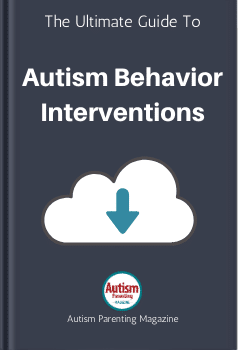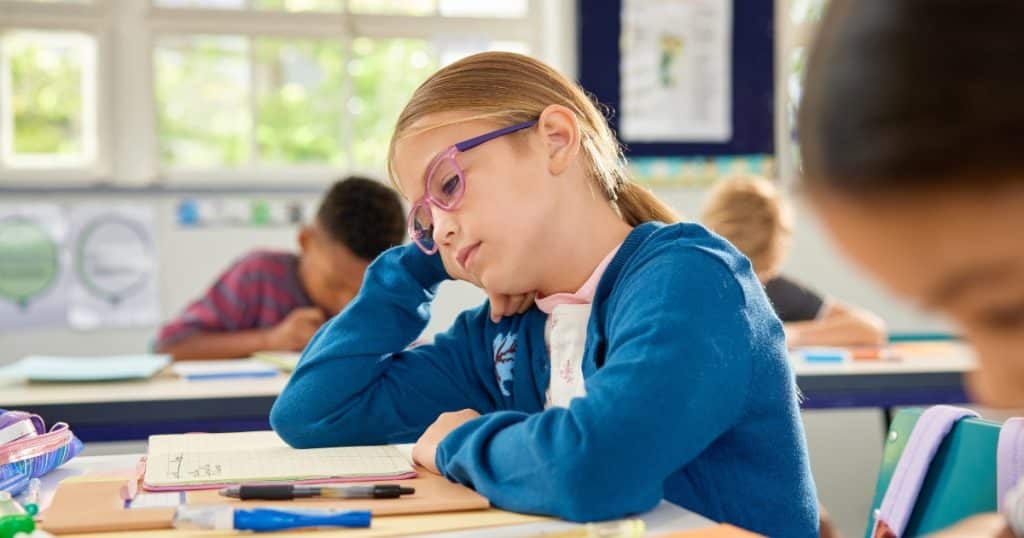It’s human nature to want to do well in school or work, especially when we enjoy the subject matter or want to impress our family. However, depending on their symptoms, some autistic children may face barriers that make getting good grades difficult.
Based on my personal experiences, here are some examples of things that may contribute to an autistic child struggling in school and how you can help them.

Download your FREE guide on
Autism Behavior Interventions
Special and restricted interests
During my elementary school years, I had strong special interests. Unless what my teachers covered was related to those interests, I would struggle to engage with the content, let alone get good marks on it.
Based on past observations, the average child might not have liked school much. However, this wasn’t typically to the extent that they couldn’t focus or engage with material without additional teacher support.
When I was seven and eight years old, I was obsessed with telling time. In grades two and three, the measurement part of the math curriculum covered time. I got an A in both years.
However, getting above a B was often a struggle with subjects I wasn’t as interested in, even with significant school work accommodations and modifications. This shows how restricted an autistic person’s interests can be and how this can potentially affect their school lives.
How can you help your autistic child struggling in school?
Set limits, especially if your child’s special interests affect their school and life progress, or if their grades reach failing or near-failing levels.
A good idea would be to set a schedule not only for when your child can do the things they want but also so they can become familiar with routines.
Also, when helping your child with homework, relate the material to their special interest or topics that mildly intrigue them. Including those interests in the material can be effective with some creativity.
Hopefully, their teacher will see the thought and effort the child has contributed and consider that when grading.
Sensory issues and getting distracted easily
Too often in school lessons, I would be understimulated to the point of intense fidgeting. Hyposensitivity and self-stimulatory behaviors were some of my most profound autism symptoms.
In primary school, I chewed my shirt sleeves and the strings, grinded my teeth, and played with my glasses. I was unaware of how such behavior prevented me from attending lessons and completing assignments.

I needed an educational assistant’s support to help with those two critical components to keep from being held back a grade.
Overstimulation was also occasionally an issue. Bright lights, foul odors, and noisy classrooms would interfere with learning and achieving desirable results.
Sometimes, these overstimulation situations would happen when I most wanted to learn.
How can parents help with sensory issues in school?
Schedule meetings with the teacher on a near monthly basis, and communicate daily how the child responds to certain sensory stimuli. Plan steps to remove problematic ones when possible.
For example, if it’s a super bright fluorescent ceiling light, the teacher can either dim the light or position the child somewhere so they won’t be as distracted by it during lessons.
Talk to the teacher about cueing the child in various ways to address fidgeting. The cues can start subtly, such as saying, “Check this out!” or “This part is very important!”
The teacher can even ask the student questions to see if they have engaged successfully with the lesson. If the child still fidgets, the teacher can be more direct in their requests to keep the autistic child’s attention.
I found that the more teachers cued me into their lessons, the easier it was for me to understand the material and achieve good marks.
Concrete and abstract learning in autism
Many people on the spectrum, including myself, are concrete thinkers. This may affect grades depending on how the teacher administers lessons or whether school staff provides accommodations or modifications to the autistic child’s learning.
My concrete thinking caused me to miss details other children picked up on, sometimes resulting in lower-quality work.
For example, if a teacher asked me to name one thing about a cube, I would say it was close to a square but bigger. Most other children would list at least one real-life example of a cube, such as a school or a present.
Thankfully, I improved at grasping abstract concepts over time, especially when teachers and educational assistants demonstrated them by modeling examples.
I also responded best to instructions when they were in front of me on paper, had visual cues, and were direct.
How do I address my autistic child’s concrete learning style?
Talk to your child’s Special Education Resource Teacher, classroom teachers, and educational assistants. Ask how they can modify curriculum expectations to support the autistic child’s learning.
Here is one example of how this can be done. A Language Arts test might have a question about the main character’s complex feelings about a particular situation.
It might state, “Describe _____’s feelings about the plot twist of this story and how they made the other person feel.” The teacher can replace the question with “Why was ______ sad when this happened?”
Monitor, understand, and communicate
Your child has lots of potential to do well in school. Monitor their interests. Understand their sensitivities or what distracts them. Communicate regularly with teachers about your child’s learning style and how they are meeting milestones.
By doing this, your child’s school experience should improve. A positive learning environment is key.
FAQs
Q: What do autistic children struggle with at school?
A: Autistic children often struggle with sensory overload, communication challenges, and social interactions at school. They may also find it difficult to cope with changes in routine or unstructured environments.
Q: How do you calm an autistic child at school?
A: Calming an autistic child at school can involve providing a quiet, sensory-friendly space and using calming techniques such as deep pressure or visual supports. Consistent routines and clear communication also help reduce anxiety.
Q: How do you help an autistic child focus at school?
A: Helping an autistic child focus at school may include breaking tasks into smaller steps, offering sensory tools, and creating a structured, distraction-free environment. Visual aids and frequent breaks can also improve concentration.
Q: How do autistic students learn best?
A: Autistic students often learn best through visual supports, hands-on activities, and structured routines. Clear instructions and individualized approaches tailored to their sensory and communication needs also enhance learning.
Q: What do autistic children struggle with in the classroom?
A: In the classroom, autistic children may struggle with sensory distractions, understanding social cues, and following rapid verbal instructions. They might also have difficulty with group work and adapting to unexpected changes in the lesson plan.
References:
Wood, R. (2023). Autism, intense interests and support in school: From wasted efforts to shared understandings. In Mapping the Field (pp. 332-352). Routledge. https://www.taylorfrancis.com/chapters/edit/10.4324/9781003403722-25/autism-intense-interests-support-school-wasted-efforts-shared-understandings-rebecca-wood
Cook, A., & Ogden, J. (2022). Challenges, strategies and self-efficacy of teachers supporting autistic pupils in contrasting school settings: a qualitative study. European journal of special needs education, 37(3), 371-385. https://www.tandfonline.com/doi/abs/10.1080/08856257.2021.1878659
Leifler, E., Carpelan, G., Zakrevska, A., Bölte, S., & Jonsson, U. (2021). Does the learning environment ‘make the grade’? A systematic review of accommodations for children on the autism spectrum in mainstream school. Scandinavian Journal of Occupational Therapy, 28(8), 582-597. https://www.tandfonline.com/doi/abs/10.1080/11038128.2020.1832145



